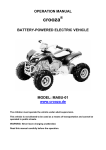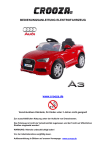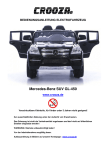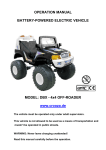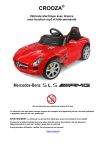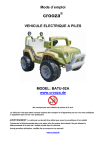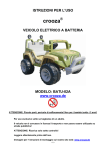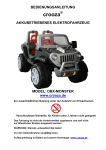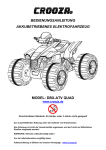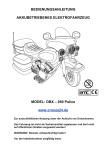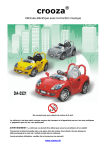Download Rastar Baby Mercedes-Benz SLK Specifications
Transcript
CROOZA® LICENCED ELECTRIC VEHICLE With Mp3 Function and Remote Control Not recommended for children under 3 years! This vehicle is not allowed to be used as a means of transportation and cannot be operated in public streets. WARNING: Never leave charging unattended! The remote control mustn’t be given to children, especially when they are sitting in the vehicle! Keep the remote control away from children. Please read the manual carefully before the operation and retain it for future reference. The vehicle must be operated only under adult supervision! www.crooza.de ELECTRIC SHOCK WARNING • Unfixed batteries may fall off the overturned vehicle and cause injuries. Ensure that the batteries have been fixed carefully. • FIRE PREVENTION - The electric system of the vehicle is not allowed to be altered. Alterations may lead to fire, black-out of the electric systems and serious injuries. - Using wrong batteries and chargers may lead to fire, explosion and serious injuries. - Only adults are allowed to handle batteries. The batteries, which are quite heavy, are filled with electrolyte. Leaking batteries may lead to serious injuries. - Do not let your children to charge the batteries. Children may get injured by an electric shock. Only adults are allowed to charge the batteries and the charging process must be supervised by an adult. Never leave charging unattended! - Please check the batteries, cable connections and the connector of the charger before charging the batteries. If you find any defects, do not charge them until they are repaired by an expert. The batteries mustn’t be charged without a good fuse. The vehicle must be off while charging. - Charging through contaminated socket can lead to short-circuit and other defects. Therefore, it must be refrained. - The charging process must be carried out safely, FAR from easily inflammable materials. Look out excessive smoke and heat generation. - The motors produce HEAT and spark! Spark! Be careful during the contact with the motors. - The charger must be used only in a dry environment. SAFE DRIVING WARNING PREVENTING INJURIES • The vehicle must be operated only under adult supervision! • Remote control must be used only by adults and kept away from children! • Never use the vehicle in darkness! • The vehicle mustn’t be used as a means of transportation! In order to prevent risks, it mustn’t be operated in public streets, highways, rock pools, river beds etc. Ensure that there are no means of transport in the vicinity. • Operation only on flat and firm grounds/areas! • Operation only on safe grounds! E.g: In areas - without swimming pools or ponds. Risk of drowning! - without inclination (excessive speed development, unexpected vehicle rolling) and slopes. - far from stairs, ramps, slopes, streets and boulevards. • Operating Directives Ensure that the following rules are followed for a safe operation: - Always sitting properly on the seat and fastening seatbelt. - No driving without shoes. ATTENTION! • Small items are included in the package at delivery status (Risk of swallowing). Assembling must be conducted only by adults. Specifications Age properly: 3-8 years (depending on the size of the child). Vehicle Size: 110 x 59.8 x 49 cm Load capacity: 25kg max. Weight: 10.3 kg Temperature range: 0-50 °C Speed: 3-4 km/h Motor: 6V Direct current Charging time: When the batteries are charged more than 8-14 hours, the vehicle works for approx. 3-4 hours (not continuously) under normal operational conditions. The batteries mustn’t be charged longer than 14 hours once. Charger: Input: AC220-240V (AC110V) / 50Hz Output: DC6V / 500mA/100mA (depending on the model) Battery: 1 x Electrolyte Battery (6V7Ah) Charging lifetime: approx. 300 WARNING! SMALL ITEMS - RISK OF SWALLOWING Not recommended for children under 3 years. PACKAGE CONTENT Nr. 1 3 Descrip. Main body Windscreen Pic. Quan. Nr. Descrip. Pic. Quan. 1 2 Steering wheel 1 1 4 External mirror 2 5 Wheel 4 6 Hub cap 4 7 Headrest 1 8 Seat 1 Nr. Descrip. 9 Mp3 Adapter 1 10 11 Battery 1 12 4 14 13 15 17 Hex nut Fixing clip Washer Pic. Quan. Nr. 4 16 Descrip. Pic. Operation manual Battery plate Hub insert Battery holder 9 18 Screw Quan. 1 1 9 1 6 19 Screw 1 20 Remote control 1 21 Key 2 22 Charger 1 23 Protection cap 6 IMPORTANT: The ends of the front and rear axles and the bar have protection caps. Before beginning the assembly, remove the protection caps and put them away. WARNING:The vehicle must be assembled only by adults! 1. Attaching the wheels 1. Remove the protection caps (23) on the ends of the front axle. 2. Put the washer (17), hub insert (14), wheel (5), fixing clip (15), hub cap (6) on the front and the rear axles; then press them carefully. IMPORTANT: It is difficult to remove the hub cap once it is attached. Therefore, it is recommended to attach the hub cap after the function of the vehicle is checked. 2. Attaching the battery 2.Attaching the battery 1. Put the battery in the place shown above. 2. Place the battery holder (16) and fix it with the screws firmly (18). 3. Link the jack and the connector together as shown. Attach the black cable to the minus pole (black flag on the battery) and the red cable to the positive pole (red flag on the battery) of the battery. (Important: Follow the instructions properly; otherwise the electric system of the vehicle will be short-circuited. 4. Put the battery plate (12) in its place and fix it with the screws firmly (18). 3. Attaching the seat 1. Put the seat (8) in the related slot and press carefully until its pins click into the main body. 2. Attach the back side of the seat carefully. IMPORTANT: The seat belt is for the purpose of decoration and must increase the safety awareness of the child. The seat belt mustn’t be considered as a real safety measure! 4. Attaching the steering wheel 1. 2. 3. 4. Remove the protection cap (23) of the steering axle. Put the steering wheel (2) in the related place and fix it with a screw (19) and a hex nut (13) (Pic.1). Attach the connector of the steering wheel to the jack of the cable on the vehicle (Pic. 2). For a good stowage and handling the cables, hang the cable in the cable holder under the instrument panel (Pic.3). 5. Attaching the windscreen, the external mirrors and the headrest 1. Put the windscreen (3) in the related place (Pic.1) and push it in the motor hood direction until everything is fixed. 2. In order to fix the windscreen, make the buckles clinch on the right and left sides (Pic. 2). 3. Place the external mirrors (4) and the headrest (7) by pressing carefully. IMPORTANT: You can attach the sides of the headrest consecutively. The assembly is now over: Attaching/Removing the batteries 1. Open the battery cover, put a 9V battery considering the poles and close the battery cover again. 2. Non-rechargeable batteries mustn’t be charged. Take the batteries out of the remote control in order to charge them. Charging the Battery & Important Instructions 1. The charging jack is under the tank cover. Open the tank cover and connect the charger with the charging jack. You can insert the charger into the socket now. 2. The batteries must be charged 8-12 hours for an approx. 1-hour operation. Never charge the batteries longer than 14 hours once. 3. A slight warming of the battery and the charger is normal and doesn’t point at any malfunction. In case of an excessive heat generation, stop charging immediately. 4. Malfunctioning charger and batteries mustn’t be used. Replacement batteries, chargers and other parts can be found on our Online-Shop at www.crooza.de. 5. Before the first operation, it must be charged as described above. The charging indicator flashes up during charging. 6. The charging process must be conducted continuously under adult supervision! Never leave the charging process unsupervised! 7. The vehicle must be off while being charged! 8. Only use the provided charger. Replacement batteries, chargers and other parts can be found on our Online-Shop at www.crooza.de. 9. In order to extend the lifetime of the battery, it must be charged at least once two months even if the vehicle won’t be used in the meantime. 10. The battery must be kept away from heat sources and water. 11. The charger is not a toy and not suitable for children! 12. Children are not allowed to charge the vehicle on their own! Operation of the Vehicle Remote control Steering wheel The signal of the remote control covers an area with a radius of 20-30 meters. In case of a performance decrease, check the batteries of the remote control. Turning left: IMPORTANT: In order to protect the steering gear, right/left buttons are deactivated automatically when pressed more than 2 seconds. Therefore, they must be pressed repeatedly and for short intervals during the steering movement. When the left steering wheel button is Pressed, a click sound is heard and the left front indicator starts blinking. Turning right: When the right steering wheel button is pressed, a click sound is heard and the right front indicator starts blinking. Horn: When the middle button is pressed, a horn sound is heard. Acceleration/ Music: Pressing the lower steering wheel button produces an acceleration sound. When it is pressed again, music starts playing. Another press directs to the next part. IMPORTANT! If no mp3 players will be used, keep the mp3 player input unplugged from the vehicle. Otherwise, steering wheel sounds are muted and not heard. Functions of the Vehicle Insert the key into the key hole and turn it right until a click sound is heard. Forward: When the forward button is pressed and the gas pedal is stepped, the vehicle moves forward. Backward: Forward: When the backward button is pressed and the gas pedal is stepped, the vehicle moves backward. Left: Turn the steering wheel left while driving forward. Right: Turn the steering wheel right while driving forward. Stop: The gas pedal is unstepped and the stop button is pressed. IMPORTANT: There is another switch under the dashboard, which has the same function with the key switch. The vehicle can be turned on and off via the both switches. When the switch is turned to OFF, the vehicle is turned off! Shifting between Remote Control Mode and Manual Mode In remote control mode, the gas pedal and the forward/stop/backward buttons are deactivated. In manual mode, the remote control is deactivated. The Low-Speed mode is activated at each start-up due to safety reasons. That is, the speed is decreased. After the gas pedal is stepped and held 2-4 seconds, the speed comes to normal. SAFETY CHECK BEFORE THE OPERATION There must be no rattling sounds like loose or broken parts. If you are unsure, please consult an experienced mechanic. Overload Protection and Overload Safety 1. There is a glass fuse for the overvoltage protection under the seat. 2. The motor has a self-reactivating fuse. The thermal fuse interrupts the current flow in case of an overload or improper use. In such a case, turn the key to OFF and wait for 30 seconds until the thermal fuse is selfreactivated. 3. The battery is protected with a glass fuse. When a short-circuit occurs, the internal safety wire burns out. Therefore, it must be replaced afterwards. ATTENTION! FIRE DANGER!NO SHORT-CIRCUIT! Replace the burnt glass fuse only with the original one. Glass fuses and other parts can be found on our Online-Shop at www.crooza.de. Short Defect-Check-List Defect Description No function Low Speed The battery can’t be charged Possible Cause • Is the battery attached correctly? If no, attach it again. • Is the forward/backward button in the right position? • Is the vehicle overloaded? • Is the circuit board of the control unit damaged? • Is there a loss of battery performance? Was the battery charged fully before (8-12 hours)? • Is the vehicle overloaded? • Are the charger and the battery in a good situation? • Is the battery attached correctly? • Is the charging jack on the vehicle damaged or are there any foreign objects in it (contaminated or blocked)? GENERAL WARNINGS The operation of the vehicle can lead to dangerous situations. Electrically powered vehicles can move automatically, which may cause dangerous situations. Therefore, it’s possible that the control of the vehicle may be lost during the operation, and this may lead to injuries or even death. LIKE EVERY MOBILE PRODUCT, THE OPERATION OF THE VEHICLE CAN LEAD TO INJURIES OR DEATH EVEN IF ALL THE SAFETY RULES ARE OBEYED AND SAFETY EQUIPMENTS ARE APPLIED. THE OPERATION OF THE VEHICLE IS AT USER’S OWN RISK AND PURSUANT TO COMMON SENSE! Please follow the local laws and regulations. The vehicle is not a means of transportation and is not allowed to be operated in public streets and on pavements. It is important that no skaters, bicyclists, other children, animals etc. cross the vehicle way. The rights of others using a specific area must be taken into account and respected. The vehicle has been designed to be operated on straight, clean, dry and flat surfaces, and shows the best performance when the given conditions are fulfilled. The operation on uneven, rough and slippery surfaces can lead to the loss of traction control or undesirable high speeds (at inclinations) and consequently dangerous situations. High speeds like downhill driving must be refrained. Functional measures such as wearing safety helmets, knee and elbow protectors are significant precautions to prevent injuries. The vehicle mustn’t be loaded with more than 25 kg. No stunts or tricks must be performed with the vehicle. Improper uses like jumping, sliding etc. must be refrained. Operations against the common sense or ignoring warnings can lead to injuries or even death. OPERATION IS AT USER’S RISK. PARENTS ARE RESPONSIBLE FOR THEIR CHILDREN. SAFETY INSTRUCTIONS 1. Use the vehicle only on flat areas. If there are high inclinations in the way, the vehicle may tumble down! 2. The remote control mustn’t be given to children! Keep the remote control away from children. 3. The vehicle mustn’t be used as a means of transportation! In order to prevent risks, it mustn’t be operated in public streets, highways, rock pools, river beds etc. 4. RISK OF CHOKING! After unpacking, dispose the package immediately. The package is not a toy; children mustn’t be allowed to play with it. Keep the original box and the Transport Protector-Styrofoam for possible guarantee situations. 5. Removable parts of the vehicle mustn’t be swallowed or played with. Supervise your children while they are driving the vehicle. 6. The vehicle is for children under 25 kg. Do not overload the vehicle. 7. During the operation, do not touch the wheels or the wheel parts. 8. Electric cables and components mustn’t be modified. Maintenance and reparation must be conducted by a professional expert. 9. Do not clean the vehicle with water. Use a soft wet cloth for cleaning. 10. If the vehicle won’t be operated for a long time, the batteries must be taken off. Keep the batteries in a cool and dry place. Keep them away from heat and fire. Charging batteries once 2 months regularly extends the battery life. 11. Recharging the batteries as soon as the speed decreases extends their life. 12. Avoid short-circuit of cable ends. 13. Do not use the vehicle in rainy weather or on a wet ground. 14. Use the specified fuses only. Instructions for A Safe Operation DANGER ! WARNING PREVENTING INJURIES • The vehicle must be operated only under adult supervision! • Never use the vehicle in darkness! • Operate the vehicle only on flat grounds! • Operation only on safe grounds! E.g: In areas - without swimming pools or ponds. Risk of drowning! - without slopes. - far from stairs, ramps, slopes, streets and boulevards. • Operating Directives - For a safe operation, ensure that these rules are learnt and followed by the children. - Always sitting properly on the seat. - Always tight holding - No driving without shoes. Explain the instructions below to your child Right after seeing the vehicle, your child will want to drive it immediately. Children are not capable of judging, realizing and assessing dangers. Unsupervised operations (like getting on and off) can lead to serious injuries. Before letting your child drive the vehicle, you must check the area and your child’s ability to judge and drive the vehicle safely. Even if children are instructed before, they are not capable of foreseeing the dangers and turning away from them. There are no other directly supervision options for adults. Set up safety rules adapted to local conditions alongside the instructions below about using the vehicle. Ensure that these instructions are followed. All of these rules must be obeyed by the children who will play with your child as well. Instructions for a safe operation: Ensure that children learn and obey the rules below: 1. Always sitting properly on the seat. 2. No driving without sturdy shoes. 3. Only one (1) child must drive the vehicle. If children sit improperly or stand in the vehicle, they may fall off; the vehicle may overturn and this may lead to serious injuries. 4. Do not allow your child to drive the vehicle in the streets or roads where motored vehicles are driven. 5. Do not allow your child to drive the vehicle near swimming pools, ponds, barriers (e.g: furniture, trees with low branches etc.) or overhanging building parts (e.g: stairs, wall projections etc.). 6. Never use the vehicle in darkness! • An unexpected barrier may cause an accident. • Driving only in daylight or well-lit areas. 7. Forbid driving in sloped areas. 8. Do not allow your child to drive down the stairs. • Even if the pedal isn’t stepped, it may reach a high and dangerous speed. • The vehicle may overturn. • The motor may stop suddenly and the vehicle may roll down together with the child. 9. Moving things must be kept away. Revolving things like motor, gearbox and wheels can jam the fingers, hair etc. and lead to serious injuries. Do not allow your child to operate the vehicle in lateral or over-head position. 10.Do not use any easily inflammable materials near the vehicle. The vehicle has electric switches which spark (like all the switches) when triggered. Easily inflammable liquids can catch fire. 11.Disconnect the battery to prevent an unsupervised operation. IMPORTANT! ATTENTION! For the safety of your child and to avoid injuries led by the gearbox of the vehicle, teach your child not to change direction while driving. The vehicle must be operated ONLY in empty places. • Practise on steering with your child and show him/her by which speed the steering wheel must be turned. A big part of floor coverings, which have been misplaced, can be damaged by the vehicle. The manufacturer and the importer are not responsible for the damages occurring on floor coverings or other building parts. • As soon as the pedal is unstepped, the vehicle stops automatically. • Ensure that your child knows how to steer and to stop the vehicle. • The stop-function may not work in sloped areas. Ensure that the vehicle is used only on flat grounds. WARNING! The vehicle has small parts which can be swallowed by children. IMPORTANT! At delivery status, the positive pole (red cable) of the battery is not attached for safety reasons. Please attach the red cable after the whole assembly and put it under the seat carefully. Maintenance Instructions Check if all the screws, nuts and protection caps are set correctly and firmly. Ensure that none of the plastic parts are damaged and broken. In snowy or rainy weather, keep the vehicle in a dry room which has a ceiling. Even if the vehicle won’t be used, charge the batteries at least once a month. A dirty vehicle can be cleaned with a soft wet cloth. Avoid any contact of water with the electric system, batteries and the switches of the vehicle. Contact of water with motor and electric components can lead to corrosion and damage on the motor and the electric components. Do not use the vehicle on the sand. Sand in the motor, gearbox or electric components causes blockades and blackouts of the related parts. The vehicle can be cleaned with a dry cloth. In order to restore the original gleam of the vehicle, you can work on the plastic parts of the vehicle with a wax free furniture polish. NEVER use a car polish. For a safe operation, it is recommended that the vehicle and the cabling are checked regularly against short-circuits. Troubleshooting Problem No sound, no light, the vehicle doesn’t move Possible Cause 1. Cable connections are loose. 2. Check the fuse. 3. Main switch/Key switch is not on. Solution Check the cable connections. Ensure that the battery is in its place under the seat. Change the fuse. Turn the main switch to ON. Although the motor works, the vehicle doesn’t move 1. Check if the rear wheel turns. 2. Tighten the E-Motor screws. 3. Defected gearbox Ensure that the rear wheels touch the ground. Remove the gearbox and tighten the screws of the E-Motor. Change the gearbox. Motor doesn’t work 1. Loose cable 2. Fuse Check if the cable connections are correct. 3. No contact with the gas pedal. Change the fuse. Change the foot switch Forward motion is OK, backward motion doesn’t function or backward motion is OK, forward motion doesn’t function 1. Check the forward/backward switch with a multimeter. Speed is very low 1. Check if the battery supplies more or less than 6V. Change the forward/backward switch. 2. Connect the motor (together with the gearbox) directly with the battery and check if the speed increases. 3. Remove the gearbox and check if it is in a good situation. Batteries cannot be charged Check if the cable connected to the switch is placed correctly. 1. Check if the output voltage of the charger is >6V. 2. Plug the charger, remove the connector from both sides of the battery and check directly the battery if 6+0.1-0.3V is supplied. Charge the batteries again. The reason for speed loss might be the condition of the ground on which the vehicle is operated. Change the E- motor and the gearbox. Change the charger. Change the battery. Ensure that the charger is connected correctly. Check the fuse. 3. Check the connector of the charger and the soldering points. Remote control doesn’t work 1. Check if the vehicle is on. 2. Turn the switch to ‘‘ON’’ to control remotely. 3. Ensure that the Control-Display of the remote control flashes up. Check the place of On/Off switches on the vehicle. Check the battery of the remote control. Check the fuse. Change the control unit. Original replacement parts can be found on Online-Shop at www.crooza.de Instructions Related to the Maintenance and Disposal of the Batteries MAINTENANCE If a battery is leaky, remove the battery which has acid escaping by avoiding skin contact and put the battery in a plastic bag. Please check the description on the right side to learn how the battery can be disposed in the right way. In the event of skin or eye contact, rinse the affected part in running water for at least 15 minutes and see a doctor. When acid is swallowed, water, milk etc. must be drunk or egg white eaten immediately. Never try to throw up. Call the doctor instantly. Before the first operation, the batteries must be charged for at least 12 hours once. Never charge the batteries longer than 16 hours once. Overloading and excessive discharge shorten the battery life and operating period substantially. Before every operation, the batteries must be charged 8-12 hours. The batteries must stand vertical while being charged. Avoid discharging the batteries completely before charging them again. Charge the batteries for a long time before putting the vehicle away. Even if the vehicle won’t be used, charge the batteries at least once a month. Batteries left empty will definitely stop working later. LOSS OF THE GUARANTEE! Never leave leaking batteries in the vehicle. Leaking liquid can damage the vehicle. Do not keep the batteries on the surfaces like the countertops in kitchens; they may get damaged. Take precautions to protect the contact surface before you put the batteries down. Do not keep the batteries in a place where the temperature is above 24 °C and below -23°C. Only use 6V batteries. Ensure that the batteries are not loose in the vehicle. Always use a battery fastener to lock the batteries. Check the batteries and the charger against imperfections and defects before every charging. If you detect a defect, do not charge the batteries until the defected part is repaired. DISPOSAL The provided battery is overflow-protected and welded. It must be ecologically disposed and recycled. Do not throw the battery into fire. It may leak or explode. Do not dispose the batteries together with normal domestic waste. Disposing the batteries with normal domestic waste is prohibited by law! Protect the environment by not disposing the batteries with normal domestic waste (2202/96/EC). Get information about recycling and disposing options from the local administration in your vicinity. (not with domestic waste!) Do not throw the battery into fire! Don’t open! The symbol „crossed-out waste container“ on the product and in the manual indicates that electric and electronic devices must be collected and disposed separately from normal domestic waste. There are various collection systems about recovery and recycling available in the EU. For more information, please consult your local authorities or your dealer. Not recommended for children under 3 years! IMPORTANT! 1. All the illustrations serve the visualization and specification of the product. If you notice differences between the illustration and the product, follow the product construction. 2. Technical modifications in whole or in part to increase the product quality are expressively reserved without prior notice. dubax-marketingoHG WEEE-Reg.-Nr.: DE 33541416 64295 Darmstadt / Germany [email protected] crooza© is a registered brand of dubax-marketing oHG "Mercedes-Benz", , and the design of the enclosed product are subject to intellectual property protection owned by Daimler AG. They are used by Rastar (HK) Industrial Company Limited under license. All rights reserved. Copying, Performing and Distributing - even in parts - only with written consent of dubaxmarketing oHG Darmstadt.




















